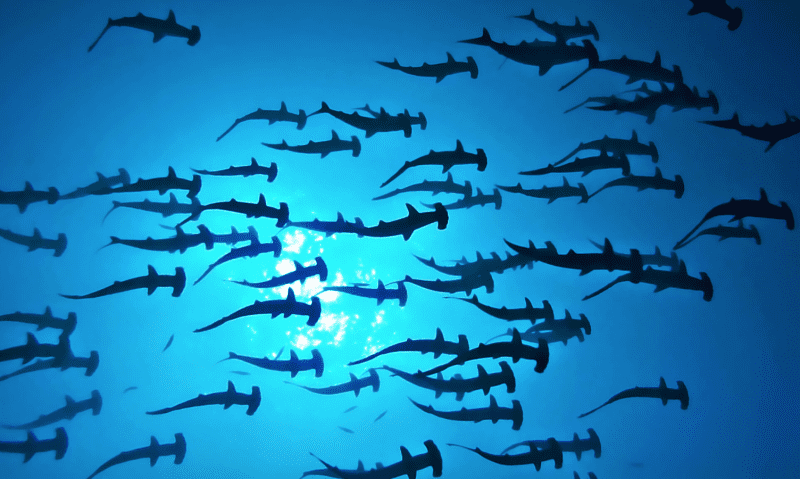A head's up on hammerheads...
IAN STALKER
No less a figure than Ecuadorian tourism minister Niels Olsen is willing to educate divers who might be nervous about some of his country’s schools. Schools of hammerhead sharks that can be viewed by the underwater exploration set who submerge themselves in Galapagos Islands waters that is… And Olsen — himself a diver — can state from personal experience that the ocean predators can be safely viewed by those who opt to go diving in the Galapagos.
The Galapagos — perhaps best known for tortoises — have dive operators that enable people to see a subsurface ocean world home to varied creatures, among them dolphins, sea lions, marine iguanas — and the unusual-looking hammerheads. Hammerheads gather in large numbers at several sites in the Galapagos, with the archipelago’s small population and ban on industrial fishing ensuring there is a good supply of food for them, and Olsen says they can be safely observed.
“You’re super safe. You’re not food for them,” he declares, adding he was 8 to 10 meters from hammerheads, known for their unusual, hammer-shaped heads, with scientists speculating that hammerheads evolved in a manner that improved their vision.

Olsen realizes that people are generally nervous about being near sharks but the International Shark Attack File has only documented 17 attacks by hammerheads on people, none of them fatal. Olsen — who says the blockbuster movie Jaws, a tale of a great white shark terrorizing a seaside New England community, was “very entertaining but fiction” — has seen as many as 30 hammerheads congregating in the Galapagos, adding the sharks showed little interest in him and his fellow divers.
Guides are trained to recognize hammerhead behaviour that suggests the fish are agitated. There are reports of schools of hundreds of hammerheads congregating during the day, but they’re solitary night hunters. Hammerheads prefer tropical water and can be found in the Galapagos year-round, feeding on marine life, including other sharks. Olsen cites the northern Galapagos’ Wolf and Darwin Islands as having particularly abundant populations of hammerheads, some types of which can reach nearly 20 feet in length.
Ecuador is one of the backers of the Cocos-Galapagos Swimway, a corridor linking the Galapagos with Costa Rica’s Cocos Island, and creating a corridor which hammerheads and other marine creatures could migrate in in greater safety. Cocos Island also has a hammerhead population. Olsen welcomes steps such as the Swimway that will help safeguard sharks, many species of which are seeing their numbers declining, and says he doesn’t view them as predators to be avoided at all costs.”I’ve loved sharks since I was a teenager,” he reports.

Meanwhile, Katie Beckwith of Quito-based Rebecca Adventure Travel says Galagagos diving with hammerheads “is a highly-sought after experience for many diving enthusiasts who visit. Thanks to that interest, there are now great standards of diving cruises that reach the islands of Darwin and Wolf, where you have the best chances to see them here and share the same patch of ocean for a short bit. “I personally have not done it but I have had plenty of guests in the past who were ecstatic about their experience.”
Beckwith cites “endless” reasons why divers should view hammerheads.
“Diving with hammerheads gives divers the opportunity to witness these incredible creatures up close and learn more about their behavior and biology,” she says, adding “hammerhead sharks are generally known for their docile nature and pose little threat to humans. However, their large size and distinct appearance can create an exhilarating diving experience.”
By diving with hammerheads, divers can gain a deeper appreciation for the “interconnectedness of marine life and the crucial role that sharks, including hammerheads, play in the ocean ecosystem,” she continues. Beckwith reports that hammerhead sharks are considered vulnerable or endangered species due to factors such as overfishing and habitat degradation, and “diving with hammerheads can help raise awareness about their conservation needs and the importance of protecting their habitats.”
More information can be found at rebeccaadventuretravel.com.

















